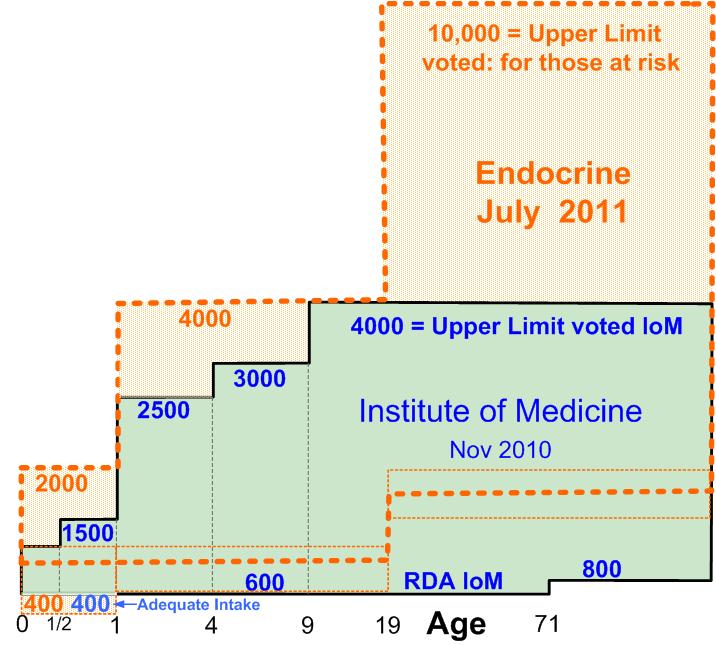Menopause group advises too little vitamin D supplementation etc.
EMAS position statement: Vitamin D and postmenopausal health
(Note: EMAS = European Menopause and Andropause Society)
Maturitas (European Menopause Journal)
Volume 71, Issue 1 , Pages 83-88, January 2012
Faustino R. Pérez-López faustino.perez@unizar.es , Marc Brincat, C. Tamer Erel. Florence Tremollieres. Marco Gambacciani, Irene Lambrinoudaki, Mette H. Moen
Karin Schenck-Gustafsson, Svetlana Vujovic, Serge Rozenberg, Margaret Rees
Received 1 November 2011; accepted 1 November 2011. published online 10 November 2011.
Introduction: There is emerging evidence on the widespread tissue effects of vitamin D.
Aims: To formulate a position statement on the role of vitamin D in postmenopausal women.
Materials and methods: Literature review and consensus of expert opinion.
Results and conclusions: Epidemiological and prospective studies have related vitamin D deficiency with not only osteoporosis but also cardiovascular disease, diabetes, cancer, infections and neurodegenerative disease. However the evidence is robust for skeletal but not nonskeletal outcomes where data from large prospective studies are lacking. The major natural source of vitamin D is cutaneous synthesis through exposure to sunlight with a small amount from the diet in animal-based foods such as fatty fish, eggs and milk. Vitamin D status is determined by measuring serum 25-hydroxyvitamin D [25(OH)D] levels.
Optimal serum 25(OH)D levels are in the region of 30–90ng/mL (75–225nmol/L) though there is no international consensus.
Levels vary according to time of the year (lower in the winter), latitude, altitude, air pollution, skin pigmentation, use of sunscreens and clothing coverage.
Risk factors for low serum 25(OH)D levels include: obesity, malabsorption syndromes, medication use (e.g. anticonvulsants, antiretrovirals), skin aging, low sun exposure and those in residential care. Fortified foods do not necessarily provide sufficient amounts of vitamin D.
Regular sunlight exposure (without sunscreens) for 15min, 3–4 times a week, in the middle of the day in summer generate healthy levels.
The recommended daily allowance is 600IU/day increasing to 800IU/day in those aged 71years and older.
Supplementation can be undertaken with either vitamin D2 (ergocalciferol) or vitamin D3 (cholecalciferol) with monitoring depending on the dose used and the presence of concomitant medical conditions such as renal disease.
PMID: 22100145
– – – – – – – – – – – – – –
Yes (need 30-90ng), no (need more than 15 minutes), no (need more than 600/800 IU), no (D3 is far better than D2)
Percentage of postmenopausal women in the UK who would get even the low end (29 ng) of the optimal vitamin D level
with either 800 IU of vitamin D and/or the amount of sunshine suggested
50% - white, low weight
15% if dark skin OR obese
4% if dark skin AND obese
These are just estimates by VitaminDWiki
Half of the seniors needed more than 1600 IU vitamin D3 – April 2011 and D2 DECREASED the level of D3 in the body
Patients older than 65 needed 5,000 IU vitamin D daily – May 2010
Half of Canadian elderly achieved 30 ng with just 560 IU – Jan 2010
- No indication if any of these seniors had dark skin or were overweight
- No indication of change with season. Perhaps the community-dwelling seniors do not get much sunshine
Guess that approximately 1/10 as many senior women would achieve 50 ng level from just 800 IU of vitamin D
No – 10 minutes per day of sun-UVB is NOT enough
WRONG most of the time
5-10 minutes is enough IF you are near the equator
AND young
AND not obese
AND have light skin
AND it is summer
AND it is the middle of the day
AND you have lots of skin exposed to the sun
AND you are lying down
AND you are not wearing sunscreen.
Vitamin D Workshop for Seniors contains the following summary chart

Vitamin D Recommendations from around the world has the following chart

Dose Response Graphs example graph:
Appears that about 10% of people achieved more than 30ng of vitamin D with less than 800 IU of supplements
This does not account for vitamin D from the sun, food, etc,, only supplements
 {IMG}
{IMG}
Also, this statement failed to recommend more IU of vitamin D to groups which are known to be at high risk, such as
Opinion by VitaminDWiki about vitamin D levels
This group got trapped by the IoM recommendations
They kept with the IoM recommendations of 600 and 800 IU of vitamin D, but recommended at least 30 ng instead of the IoM of 20 ng
They wanted higher ng (as does virtually all of the literature), but failed to increase IU
Cynical opinion
This group is reluctant to promote vitamin D, and it will reduce their jobs
Quote from Upton Sinclair
"It is difficult to get a man to understand something when his salary is dependent upon his not understanding it”
